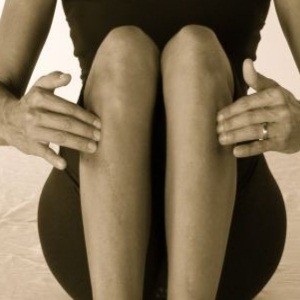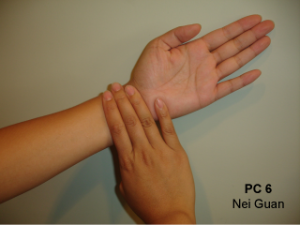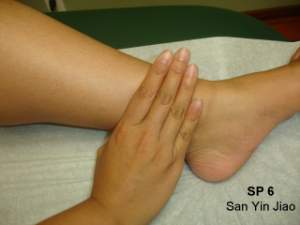 Let me start with a discussion of how to locate the acupressure points used in Traditional Chinese Medicine (TCM).
Let me start with a discussion of how to locate the acupressure points used in Traditional Chinese Medicine (TCM).
The first thing to know about holding acupressure points is that you shouldn’t worry excessively about finding the exact location. Because acupuncturists insert needles below the skin and need to be careful to avoid nerves and blood vessels, they locate points very precisely. With acupressure, you don’t need to be concerned about the exact location of a point. The surface area on the skin that allows you to influence the point (to draw energy to the surface) is about the size of a silver dollar or the width of three fingers.
Locate with one finger, hold with three
You can use your index finger to locate a point. At many points you’ll find a slight indentation in the tissue, about the size of your fingertip. Also, the directions I provide for locating a point often instruct you first to find a bodily landmark (the inner end of the eyebrow, the tip of the ankle bone), which you can do with the index finger. Once you find the point, however, hold it with three fingers. You want to relax the tension around a point, and three fingers is a more comforting touch than one finger. Since the size of the area around a point that will be influenced by your touch is about the width of three fingers, when you use three fingers, one of them will almost certainly be directly on the point.
It’s best not to use your thumb to hold a point. As mentioned below under How long should I hold a point?, you will feel a pulse at the area you are holding when the energy is drawn to the surface. If you are holding a sequence of points, this is an indication that you can now move on to the next point. The pulse in the thumb is much stronger than the pulse in the fingers, so holding with the thumb does not provide useful information. It’s not wrong — most of the photos I see online illustrating acupressure show the thumb holding a point. That’s not necessarily ineffective. It’s just not as informative.
Locating points by measuring with your fingers
 One more thing about locating TCM acupressure points. The directions I give on this site instruct you to use your fingers to measure distances on the body (e.g., four fingers up from the tip of the ankle bone). Your fingers are the perfect measuring tool for your body. The width of your thumb is one body inch (“cun” in Chinese) on your body.
One more thing about locating TCM acupressure points. The directions I give on this site instruct you to use your fingers to measure distances on the body (e.g., four fingers up from the tip of the ankle bone). Your fingers are the perfect measuring tool for your body. The width of your thumb is one body inch (“cun” in Chinese) on your body.
You’ll see instructions telling you to measure distances of two fingers, three fingers, and four fingers. Three fingers up from the wrist crease, for example, means that you start by placing the edge of your ring finger at the wrist crease. Three fingers up takes you to the outer side of the index finger. (Occasionally the instructions will indicate that the location of the point is three fingers up, but under the center of the third finger, not at the outer edge of the third finger.) The photo below shows measuring four fingers up from the tip of the ankle bone.
 Don’t worry about all this right now or try to remember it. Specific information is included in each set of instructions, so the location of the point will be clear once you read the instructions. What you might want to note, however, is that your fingers measure distances on your body. If you are using acupressure on someone else who is much larger or smaller than you are, you might want to notice how the size of their hands compares to the size of yours.
Don’t worry about all this right now or try to remember it. Specific information is included in each set of instructions, so the location of the point will be clear once you read the instructions. What you might want to note, however, is that your fingers measure distances on your body. If you are using acupressure on someone else who is much larger or smaller than you are, you might want to notice how the size of their hands compares to the size of yours.
How to locate and hold Jin Shin Jyutsu points
Now let me say a word about locating and holding Jin Shin Jyutsu (JSJ) points. These are not called “points,” as in TCM, but Safety Energy Locks (SELs). Acupuncturists and acupressurists use hundreds of points (out of possibly as many as 2000), but there are only 26 SELs.
 Like TCM points, SEL locations are usually described in relation to bodily landmarks. For example, there’s a major point for shoulder tension that I call the “coat hanger” point. You curve the fingers of one hand as if they were the top of a coat hanger. Then you hang your fingers on the top of the opposite shoulder. The side of your thumb should rest against the base of your neck.
Like TCM points, SEL locations are usually described in relation to bodily landmarks. For example, there’s a major point for shoulder tension that I call the “coat hanger” point. You curve the fingers of one hand as if they were the top of a coat hanger. Then you hang your fingers on the top of the opposite shoulder. The side of your thumb should rest against the base of your neck.
 Some other examples of locating SELs: Measure four fingers down (the width of four fingers) from the center of the collar bone; measure four fingers up from the navel and then move straight out until you reach the rib cage. The location of JSJ SELs is described in each JSJ self-help instruction on this site.
Some other examples of locating SELs: Measure four fingers down (the width of four fingers) from the center of the collar bone; measure four fingers up from the navel and then move straight out until you reach the rib cage. The location of JSJ SELs is described in each JSJ self-help instruction on this site.
In general, once you’ve located an SEL, you can hold it with all four fingers. Some SELs are even held with the fist, such as SELs on the lower back or under the hip.
How much pressure should I use?
The word “pressure” in “acupressure” is misleading. In acupressure, we are using an energetic touch, inviting the qi (chi) that flows through the energy channels to rise to the surface.
Acupressure points are precisely where energy comes to the surface most easily. If you press too hard, you’ll be blocking the flow of energy rather than relaxing the area that surrounds the point. An analogy that one of my teachers liked to use is that of a plug in a wall outlet. Once the plug connects with the electricity in the wall, you don’t need to press hard on the plug.
It’s the same with acupressure points. You’re making an energetic connection. If there is considerable muscle tension in the area where the point is located (e.g., the top of the shoulders), you can loosen up the area with a little self-massage before holding the point.
How long should I hold a point?
There are three ways to know that energy is flowing through an acupressure point (and no longer “stuck”).
- You may feel a softening of the muscle or tissue. When the area around a point relaxes, the energy can flow smoothly.
- You may feel an increase in warmth in the area of the point. This indicates that blood is flowing more readily in the area. Energy follows blood. When blood flow is enhanced, so is the energy flow.
- You may feel a pulse at the point. This is also an indication that the blood is flowing in this area. But the pulse you are feeling is actually the pulse of the energy. This is why I recommend using your fingertips to hold points rather than the thumbs. When you use your thumb, you may be feeling the pulse in your thumb, not the pulse of the underlying point.
When you first start doing acupressure on yourself, don’t expect to feel the pulse. As you practice acupressure self-help and do it regularly, your energy will become more balanced, and your pulses will become stronger. Once you can feel pulses at the points or SELs, this tells you how long to stay in that location.
When “listening” for a pulse, at first you will not feel anything. Then the pulse will arrive. Once the pulse arrives, stay with it for a while, then — if you are holding a sequence of points/SELs — move on to the next location. If you are holdling a sequence and do not feel a pulse, hold for about a minute before moving on.
This rule of thumb on how long to hold a point/SEL — hold for a minute or until you feel a pulse — can vary. If you are holding only one point for a specific condition (for example, the TCM migraine point in the foot), you can keep holding the point as long as you’d like (ideally until the pain diminishes). Some JSJ flows call for holding an SEL for 15 minutes (e.g., the flow I use for scoliosis).
I’ve tried to include a brief indication in each acupressure self-help description of how long to hold points/SELs. As with exact point locations, try not to be overly concerned about how long you hold a point. What’s more important is regular practice.
Image sources:
Holding with three fingers: Explore IM
Measuring with three fingers: Motion Sickness Guru
Measuring with four fingers: Explore IM
